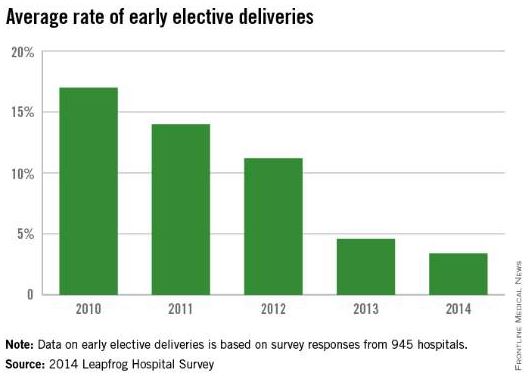The practice of early elective deliveries is down across the country, but there is still wide variation in meeting maternal quality indicators at U.S. hospitals, according to a new report from the Leapfrog Group.
Among 945 hospitals that voluntarily reported quality data to the Leapfrog Group, 78% performed early elective deliveries less than 5% of the time in 2014. The current data shows a steady decline in the early elective deliveries – scheduled cesarean deliveries or elective inductions that occur prior to 39 weeks’ gestation without a medical indication. Between 2010 and 2014, the national average rate of early elective deliveries dropped from 17% to 3.4%.
But variation remains. Among 82 hospitals that reported data in 2014, the rate of early elective deliveries was more than 10%. The rate was higher in rural areas than at hospitals in urban areas, the report found.
The Leapfrog Group report also shows some small gains in decreasing the use of episiotomy at U.S. hospitals. The national average rate of episiotomies decreased from 13% in 2012 to 11.3% in 2014.
However, there was also wide variation in this measure. Of the 990 hospitals that reported episiotomy data, 65% met the Leapfrog goal of performing the procedure 12% of the time or less. In 25 hospitals, the rate was 1% or less, while it was 40% or more in 12 hospitals.
U.S. hospitals have made virtually no progress in ensuring that high-risk deliveries are performed at hospitals with experienced, on-site neonatal intensive care units, according to the report.
Hospitals met the Leapfrog standard for high-risk deliveries if they delivered at least 50 very-low-birth-weight babies per year and ensured that at least 80% of mothers received antenatal steroids prior to delivery, or if they maintained a lower-than-average morbidity/mortality rate for very-low-birth-weight babies and provided antenatal steroids prior to delivery for at least 80% of mothers.
In 2014, the number of high-risk deliveries that occurred in hospitals meeting the Leapfrog standard was 24.4% of 435 hospitals, compared with 24% of 451 hospitals during the previous year.
The Leapfrog Group report relies on voluntary reporting from adult general acute care and freestanding pediatric hospitals across the United States. The report was prepared by Castlight Health.
mschneider@frontlinemedcom.com
On Twitter @maryellenny



